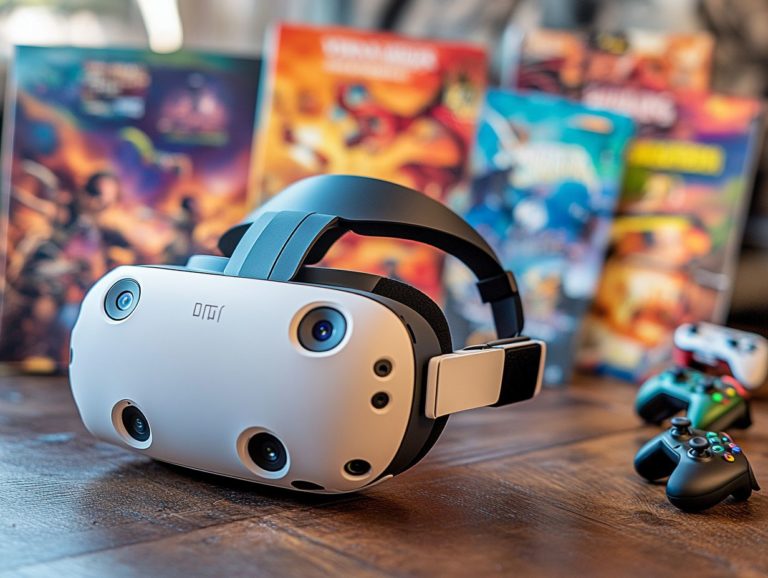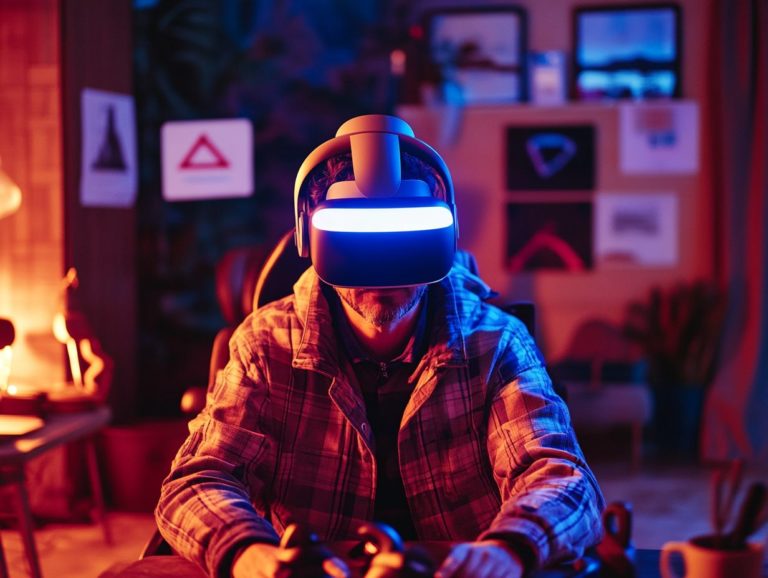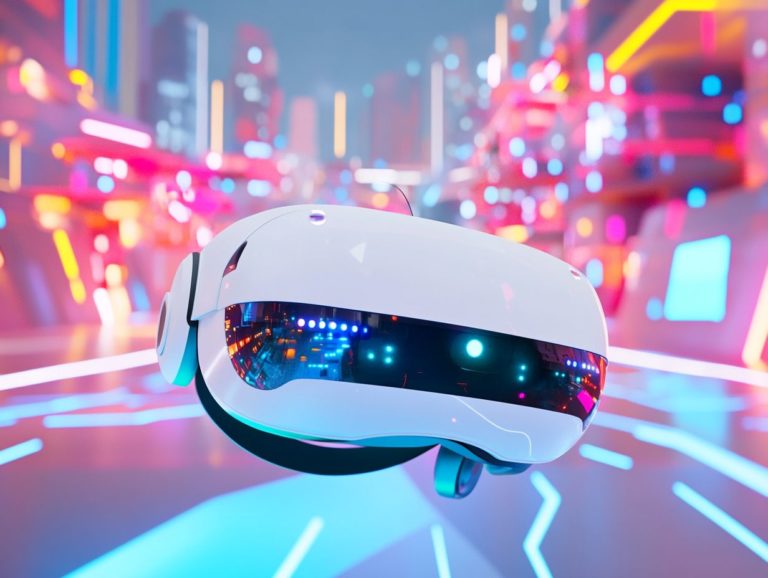key features to look for when buying vr gear
Virtual reality (VR) gear has revolutionized your experience of digital content, delivering exciting experiences that mix real life with your imagination.
With various headsets, controllers, and accessories at your fingertips, selecting the right setup can feel daunting.
This guide simplifies the essentials of VR gear by breaking down the different types and emphasizing crucial features to consider, such as resolution, comfort, and connectivity. It also offers practical tips to help you make a well-informed decision tailored to your budget and intended use.
Dive in to discover how to pick the perfect VR gear for you!
Contents
- Key Takeaways:
- Types of VR Gear
- Key Features to Consider
- Factors to Think About Before Buying
- Frequently Asked Questions
- Q1: What are the key features to look for when buying VR gear?
- Q2: Why is screen resolution important?
- Q3: What is field of view and why is it important?
- Q4: How does tracking capability affect the overall VR experience?
- Q5: Is comfort an important factor when choosing VR gear?
- Q6: Can I use any VR gear with my device?
Key Takeaways:
Pay attention to resolution and comfort when buying VR gear. Check your budget and read reviews to make the best choice.
What is VR Gear?
VR gear includes a variety of devices designed to deliver exciting virtual reality experiences, primarily through headsets that enhance your interaction with digital environments.
This technology has transformed gaming, inviting you to step into captivating virtual worlds that feel astonishingly real. VR gear is evolving rapidly, expanding its applications into gaming, education, and creative endeavors, making it a versatile addition to the tech landscape.
These headsets come in different formats. Tethered models connect to powerful gaming PCs, while standalone versions grant you the freedom of portability without needing a computer.
Advanced sensors and high-resolution displays work together to track your movements and adjust visuals in real-time, ensuring an uninterrupted experience.
VR gear also plays a crucial role in training simulations for medical professionals, immersive storytelling in filmmaking, and enriching virtual classrooms. Imagine students exploring faraway places or historical events in a fun and interactive way!
The wide-ranging applications of VR technology highlight its emergence as an essential tool across diverse sectors, pushing the boundaries of traditional experiences.
Types of VR Gear
In the expansive realm of virtual reality, a variety of VR gear awaits you, each designed to cater to the diverse needs and preferences of users, especially gaming enthusiasts.
The primary categories include VR headsets, controllers, and accessories, which can be divided into tethered and standalone devices. Each has its unique advantages and considerations.
Gaining a clear understanding of these distinctions gives you the power to make informed choices tailored to your gaming needs and the immersive VR experiences you seek.
Headsets, Controllers, and Accessories
Headsets, controllers, and accessories form the backbone of the VR ecosystem, enhancing your overall experience and immersion in virtual environments.
When you slip on a VR headset like the Oculus Rift or the Meta Quest 2, you’re greeted with various levels of resolution and tracking methods that set the tone for your adventure. The controllers you use amplify interactivity and engagement, making your journey in the virtual realm even more captivating.
Supplementary accessories, like additional gaming peripherals, further enrich your VR experience, unlocking new avenues for exploration and creativity.
For instance, the Oculus Rift’s high-resolution displays and cutting-edge tracking technology allow for precise movements, delivering a visually captivating experience. The HTC Vive offers room-scale tracking, giving you the freedom to move and interact with your surroundings.
Don’t underestimate the significance of controllers; they provide tactile feedback and intuitive control that significantly enhance the gaming experience.
Accessories like haptic gloves and external sensors elevate your immersion and adapt to the latest technological advancements, allowing you to fully embrace the ever-expanding possibilities of virtual reality.
Key Features to Consider
When selecting VR gear, understanding what you should look for in VR equipment is vital for crafting an immersive experience tailored to your gaming preferences.
Consider aspects like resolution, display quality, comfort, compatibility with your gaming PC or console, and connectivity options such as wireless capabilities. These factors can significantly influence the functionality and enjoyment of VR technology.
Carefully evaluating these elements helps you make informed decisions that will enhance your virtual reality experiences for the long run.
Resolution and Display Quality
Resolution and display quality are crucial in shaping your immersive experience with VR headsets. They directly influence clarity and engagement in virtual environments.
Take the Valve Index, for example. Its impressive refresh rate of 144Hz creates remarkably smooth motion, reducing the chance of discomfort during those thrilling gaming sessions.
High pixel density ensures that every detail appears crisp and lifelike, transforming virtual worlds into believable realms. While the Oculus Quest 2 offers notable resolutions that improve pixel clarity, you might notice a slight screen door effect if you look closely.
These elements collectively make your experience better, highlighting why resolution and display quality are essential for advancing and popularizing VR technology.
Comfort and Fit
Comfort and fit are critical when choosing a VR headset. A well-designed device can greatly enhance your experience while minimizing motion sickness during long sessions.
A snug and comfortable fit can lead to deeper immersion and longer enjoyment of virtual reality applications. Whether seated or standing, the right fit optimizes positional tracking and allows for seamless interaction in virtual environments.
The choice of materials also affects your overall satisfaction. Breathable fabrics help keep you cool during lengthy sessions, while soft padding adds extra comfort.
Adjustable straps are essential for customizing the fit to your head shape, preventing unwanted movement during action-packed moments. A well-thought-out weight distribution system can alleviate pressure points, further enhancing comfort.
By incorporating thoughtful design elements, manufacturers can create headsets that not only look stunning but also deliver an exceptional experience, keeping you fully engaged without distractions.
Compatibility and Connectivity
Compatibility and connectivity are essential factors when selecting VR gear because they dictate how well a headset integrates with various gaming platforms.
It’s important to know whether a VR headset requires a VR-ready PC or if it can operate independently, as this knowledge helps optimize your gaming experience.
For gaming PCs, you’ll often need powerful graphics cards, ample RAM, and fast processors to deliver immersive visuals and smooth performance.
Consoles usually have different specifications but typically offer a straightforward setup that can be appealing.
While wireless connections provide the freedom to explore virtual worlds without being tethered, they can sometimes introduce latency issues. On the other hand, wired connections tend to offer more stable performance.
Finding the right balance among these factors can greatly enhance your enjoyment and the functionality of your VR devices.
Factors to Think About Before Buying
Before making a purchase, consider these important factors to ensure the VR gear you choose aligns with your preferences and gaming needs.
Your budget is a major consideration that helps narrow down your options. After all, VR headsets can range from budget-friendly models like Google Cardboard to premium offerings such as the Varjo XR-3 or Apple Vision Pro.
Knowing how you plan to use the headset whether for gaming, creative endeavors, or immersive experiences is essential for your decision-making process.
Don’t wait too long find a headset that fits your budget now!
Budget and Intended Use
Your budget and intended use matter when picking a VR headset. Knowing the price range helps you find options that fit your gaming or creative needs.
If you re a gamer, look for high refresh rates. These features enhance your virtual experience.
For creative work, prioritize headsets with detailed 3D modeling and precise motion tracking.
In education, features like interactive learning and access to educational content are key.
Evaluating these features against your budget ensures you invest wisely in VR technology.
User Reviews and Recommendations
User reviews are invaluable for buying a VR headset. They help you make informed choices.
Insights from gamers reveal real experiences and highlight important features. Comfort, tracking methods, and performance matter.
Understanding the pros and cons becomes easier with firsthand feedback. For example, if a headset is known for its immersive capabilities but criticized for comfort, that s vital for long gameplay.
Community reviews stress the importance of software compatibility and support. Consider not just the hardware, but the overall experience.
Engaging with discussions and reading reviews empowers you to choose options that match your gaming preferences.
Frequently Asked Questions
Q1: What are the key features to look for when buying VR gear?
A1: Key features include screen resolution, field of view, tracking capability, comfort, compatibility, and controllers.
Q2: Why is screen resolution important?
A2: Screen resolution affects the clarity of images in virtual reality. Higher resolution means a better immersive experience.
Q3: What is field of view and why is it important?
A3: Field of view refers to how much of the virtual world you can see through the headset. A wider field of view enhances realism and immersion.
Q4: How does tracking capability affect the overall VR experience?
A4: Tracking capability determines how well the VR gear translates your movements into the virtual world. Better tracking leads to a more immersive experience.
Q5: Is comfort an important factor when choosing VR gear?
A5: Yes, comfort is crucial for longer VR sessions. Look for adjustable straps, lightweight materials, and cushioned padding.
Q6: Can I use any VR gear with my device?
A6: Compatibility is important. Some VR headsets work only with specific devices or operating systems, so check before purchasing.





